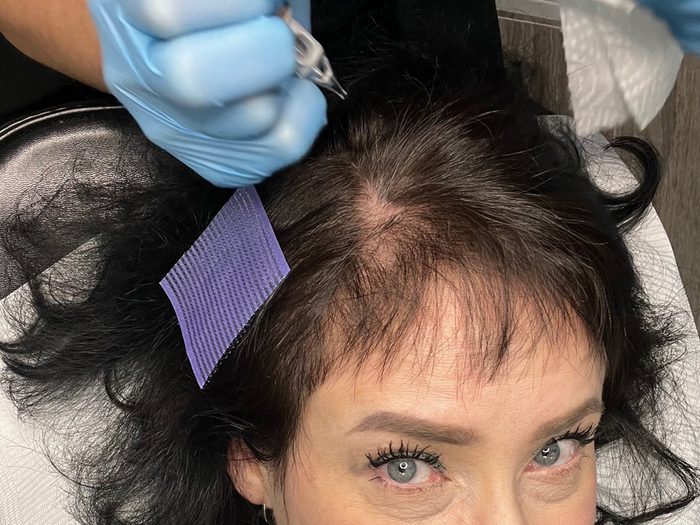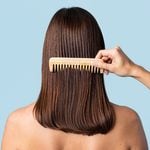I Tried a Hairline Tattoo to See If It Could Cover Up My Balding Head

As soon as I hit my late forties, I started noticing sparse patches of hair on my head. After weighing my treatment options, I decided to get a hairline tattoo—here's what happened.
The photo is horrifying. Taken from behind, the offending piece of evidence shows a spreading white circle at the crown of my head that glows as if it’s desperately signaling to its alien pals in a dimension far, far away. The evidence is clear: I’m not just going grey—I’m also going bald. And I’m not alone.
Hair loss in women can be sparked by a laundry list of factors including genetics, thyroid issues, stress, vitamin and mineral deficiency, the hormonal blitzkrieg of menopause and the general effects of aging on all our tissues, including the lusciousness of our locks. According to the Canadian Dermatology Association, about 40 percent of women will experience some form of hair loss by the time they hit 50. Since I pride myself on always being right on time, I started noticing naked spots as soon as I hit my late forties. I’ve never been a glorious Rapunzel, but this is just rude. Wearing a jaunty beret every day seems cute but impractical, so I started researching options. Treatments like platelet-rich plasma injections straight into my scalp to kick start hair growth or teeny, tiny hair transplants are expensive and painful; a topical like Rogaine is way too slow; and daily use of colour sprays have destroyed my pillowcases and couch. But then I discover a relatively simple way to fill in the sparse areas on my lid: a tattoo.
(Related: The Root Cause of Thinning Hair and Hair Loss for Women)
Scalp Micropigmentation, or SMP, is a cosmetic procedure that uses micropigmentation—a permanent makeup technique that’s already popular for filling in sparse eyebrows and tattooing on freckles— on the scalp. Artists use a pen-like tattoo machine to draw thousands of tiny dots that mimic hair follicles. If you’re bald, the results will look like you’ve just shaved your head, and if you still have hair but want to fill in some areas like I do, it camouflages the empty spots and makes the surrounding hair look thicker. It can also help hide scars and can be used on all skin tones, though if your scalp is prone to inflammatory skin conditions like psoriasis or eczema, you’ll have to clear that up before you can get SMP.
SMP is newish and permanent makeup isn’t regulated in Canada, making it simple for anyone to take a weekend course and say they’re certified, so it’s very much buyer beware when it comes to choosing a technician. SMP uses special inks and is super precise—if you go too deep with the needle the ink can spread into ugly blobs, but if you don’t go deep enough the colour will fade quickly—so it’s key to go to someone who has experience and whose facilities have passed municipal health code inspections (i.e. not some lady who does SMP as a side hustle in her basement!). A good place to look for a skilled practitioner is a medically supervised hair transplant clinic that also offers SMP. But I decide to go old school with a recommendation from Pretty in the City owner Veronica Tran, a permanent makeup artist who I’d gone to for my eyebrows, and end up at Scalp Amplified Studios in Oakville. “I’ve seen people tattooing people’s heads after watching videos on YouTube,” shudders owner Renata Pruszewski. “There are a lot of botch jobs coming out.” Pruszewski has been doing permanent makeup for 13 years, was one of the first SMP practitioners in Canada and has racked up several international SMP awards, so I feel safe in her hands. Which is good, because I’m going to be spending a lot of time with her scribbling on my head. People who want to cover near or total baldness need anywhere between two and four sessions at two to four hours each—it takes a lot of time to draw on all those wee dots—but because I still have a fair amount of hair, Pruszewski says I’ll only need two visits.
While the cost varies depending on how complicated the job is, prices start at around $700 per session. I’m game, but I’m worried about what will happen when my husband finally manages to pry the hair-dye bottle out of my cold, dead hands and I eventually let my hair go grey—an inevitability that even the vainest among us (hi! me!) must eventually face. Will I have a weird dark tattoo helmet under my snow-white locks? Pruszewski assures me that hair follicles are related to your skin tone, not the colour of your hair, so the SMP dots will still look natural even if I give up dyeing my hair. And, like all tattoos, SMP fades with time, especially if you’re not applying sunscreen—which most women don’t do to their scalp, even though there are specialty SPF sprays. While the results can technically last up to seven years, Pruszewski says many clients come in for touch-ups at the two-year mark.
I’m ready, and I feel bold. I was an emo Gen Xer, after all, which means I already have two actual tattoos. How bad can this be? The answer is: It’s not bad at all. While it’s definitely not pleasant, I find it pretty tolerable, like she’s drawing on my scalp with a very sharp pen for three hours. I’m able to chit chat and look at my phone, which, in my books, is about as good as it gets for a semi-permanent procedure involving a needle. There’s no bleeding, but my scalp is red and sore for a week, and so, so itchy. I’m not allowed to sweat excessively or wash my hair for three days (best. shower. ever), and while you’re technically fully healed after two weeks, Pruszewski says I shouldn’t dye my roots for a month.
But the results are instantaneous. When done well, SMP is both extremely subtle and quite noticeable in that it looks better, but you can’t tell what, exactly, has been done. And if the flood of intrigued messages I got from women after I posted some before-and-after pics on Instagram is any indication, it’s a procedure that’s about to get a lot more popular.




